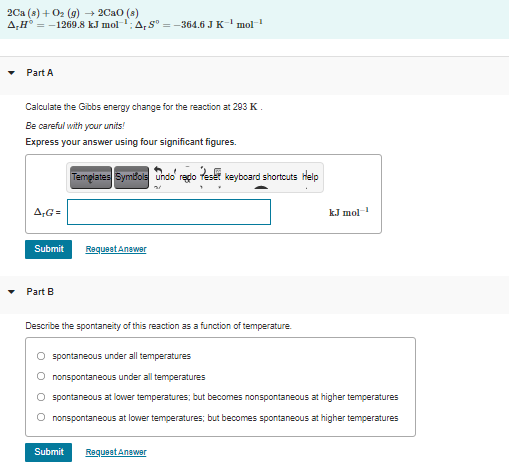2Ca (8) + O2 (g) + 2Cao (a) A,H° = -1269.8 kJ mol: A, S° = -364.6 JK- mol Part A Calculate the Gibbs energy change for the reaction at 293 K. Be careful with your units! Express your answer using four significant figures. Templates Symbols uhdo' redo feset keyboard shortcuts help A;G= kJ mol Submit Requeet Anawer Part B Describe the spontaneity of this reaction as a function of temperature. O spontaneous under all temperatures O nonspontaneous under all temperatures O spontaneous at lower temperatures; but becomes nonspontaneous at higher temperatures O nonspontaneous at lower temperatures; but becomes spontaneous at higher temperatures Submit Requeet Answer
2Ca (8) + O2 (g) + 2Cao (a) A,H° = -1269.8 kJ mol: A, S° = -364.6 JK- mol Part A Calculate the Gibbs energy change for the reaction at 293 K. Be careful with your units! Express your answer using four significant figures. Templates Symbols uhdo' redo feset keyboard shortcuts help A;G= kJ mol Submit Requeet Anawer Part B Describe the spontaneity of this reaction as a function of temperature. O spontaneous under all temperatures O nonspontaneous under all temperatures O spontaneous at lower temperatures; but becomes nonspontaneous at higher temperatures O nonspontaneous at lower temperatures; but becomes spontaneous at higher temperatures Submit Requeet Answer
Chemistry
10th Edition
ISBN:9781305957404
Author:Steven S. Zumdahl, Susan A. Zumdahl, Donald J. DeCoste
Publisher:Steven S. Zumdahl, Susan A. Zumdahl, Donald J. DeCoste
Chapter1: Chemical Foundations
Section: Chapter Questions
Problem 1RQ: Define and explain the differences between the following terms. a. law and theory b. theory and...
Related questions
Question

Transcribed Image Text:2Ca (8) + O2 (g) + 2Cao (a)
A,H° = -1269.8 kJ mol: A, S° = -364.6 JK- mol
Part A
Calculate the Gibbs energy change for the reaction at 293 K.
Be careful with your units!
Express your answer using four significant figures.
Templates Symbols uhdo' redo feset keyboard shortcuts help
A;G=
kJ mol
Submit
Requeet Anawer
Part B
Describe the spontaneity of this reaction as a function of temperature.
O spontaneous under all temperatures
O nonspontaneous under all temperatures
O spontaneous at lower temperatures; but becomes nonspontaneous at higher temperatures
O nonspontaneous at lower temperatures; but becomes spontaneous at higher temperatures
Submit
Requeet Answer
Expert Solution
This question has been solved!
Explore an expertly crafted, step-by-step solution for a thorough understanding of key concepts.
This is a popular solution!
Trending now
This is a popular solution!
Step by step
Solved in 2 steps with 2 images

Knowledge Booster
Learn more about
Need a deep-dive on the concept behind this application? Look no further. Learn more about this topic, chemistry and related others by exploring similar questions and additional content below.Recommended textbooks for you

Chemistry
Chemistry
ISBN:
9781305957404
Author:
Steven S. Zumdahl, Susan A. Zumdahl, Donald J. DeCoste
Publisher:
Cengage Learning

Chemistry
Chemistry
ISBN:
9781259911156
Author:
Raymond Chang Dr., Jason Overby Professor
Publisher:
McGraw-Hill Education

Principles of Instrumental Analysis
Chemistry
ISBN:
9781305577213
Author:
Douglas A. Skoog, F. James Holler, Stanley R. Crouch
Publisher:
Cengage Learning

Chemistry
Chemistry
ISBN:
9781305957404
Author:
Steven S. Zumdahl, Susan A. Zumdahl, Donald J. DeCoste
Publisher:
Cengage Learning

Chemistry
Chemistry
ISBN:
9781259911156
Author:
Raymond Chang Dr., Jason Overby Professor
Publisher:
McGraw-Hill Education

Principles of Instrumental Analysis
Chemistry
ISBN:
9781305577213
Author:
Douglas A. Skoog, F. James Holler, Stanley R. Crouch
Publisher:
Cengage Learning

Organic Chemistry
Chemistry
ISBN:
9780078021558
Author:
Janice Gorzynski Smith Dr.
Publisher:
McGraw-Hill Education

Chemistry: Principles and Reactions
Chemistry
ISBN:
9781305079373
Author:
William L. Masterton, Cecile N. Hurley
Publisher:
Cengage Learning

Elementary Principles of Chemical Processes, Bind…
Chemistry
ISBN:
9781118431221
Author:
Richard M. Felder, Ronald W. Rousseau, Lisa G. Bullard
Publisher:
WILEY